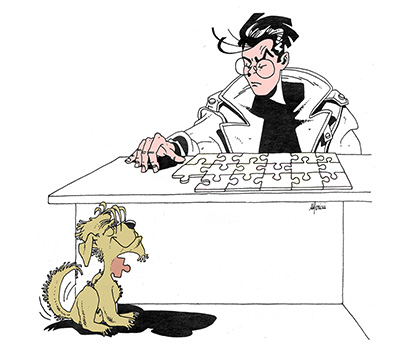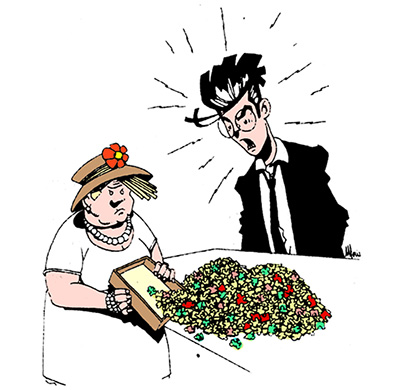The puzzle collapsed
Sooner or later it is going to happen to everybody. Most framers have their own tragic story to tell about it. Let’s try to turn an accident into enjoyment.
Unfortunately it usually happens when you are dealing with a large puzzle. Imagine the scene. You can’t get it to pass through the door and so you attempt to fold it just that little bit in order to get it to pass through the door when... it collapses.
The most common “collapses” occur when you are moving it from one work bench to another or it gets pushed or when large puzzles stick out from the edges of the bench and it is knocked by some passer by.
What do we do? The first thing is not to panic.
The second thing is to immediately start picking up the pieces on the floor. You must attempt to find all pieces? Finding 99 out of 100 is not good enough.
Look under all tables, chairs and benches. It is wise to postpone the cleaning/vacuuming of the room until after the puzzle has been completely reconstructed. It is only then that we will be able to establish if there are any missing pieces.
If the puzzle has completely disintegrated then we have no alternative than to put all the pieces indiscriminately into one big box. If however the puzzle has not completely dismantled then it would be wise to shift the pieces left intact onto a separate cardboard sheet.
There is nothing much left at this stage to do than to console ourselves at having found some enjoyment for the evening or for the week-end. It is probably preferable to take it home.
Don’t forget to take a sheet of cardboard (or other rigid material) with you.
Try and get the family involved by convincing them that it is an enjoyable pass time. It will be worth your while.
Reconstructing the puzzle
How? There are specific rules to be followed to be able to complete the job in the least time possible. If the team works together it will completed efficiently. Lets see how.
• First of all spread a sheet of cardboard onto a large enough table.
The cardboard should be however not be that much bigger that it creates difficulties for transporting it. If you think that you will be unable to finish the puzzle soon enough then you must realise that the space dedicated to it will be unavailable for this period.
• No dogs and cats can be form part of the reconstructing team. They are liable to eat or damage the pieces. Small children are likely to do the same.

• Having the picture of the puzzle makes it easier. The customer is most likely to still have it is in possession.
The framer may not want to ask the customer fearing that it may reflect on his lack of organisation.
The customer could have a drastic reaction by taking the work away from you.
They may even want to do egotistically enjoy themselves at reconstructing the puzzle.
But maybe our real fear consists in the possibility that our toy for the weekend is going to taken away from us.
There may be ways of avoiding asking the customer. If the puzzle is a reproduction of a famous painting then it may be possible to find a picture of it in an art book. I once reconstructed a puzzle that was a reproduction of a Bruegel painting by finding it in a library nearby.
• If some pieces have stayed joined place them in their expected position on your board. avranno alla fine.
• The loose pieces, that are in the box, should first be placed in homogenous groups. For example all sky blue pieces should be separated and placed in one heap. The green will probably constitute the vegetation in the puzzle.
The separation into groups makes it easier later on and makes it easier to work in groups. Each person can dedicate him/herself at finishing one distinct part of the puzzle. If you are completing the puzzle yourself it is probably still wise to use this system.
• The straight edge (border) pieces should be separated as they are easier to spot and join. The easiest without a doubt are the corner pieces (its a pity that there aren’t more than 4). They should be placed immediately.
That missing piece
After having placed all pieces at your disposal there is often that one piece missing. The most obvious first step is to go searching for it. If you are not successful, there are some alternative solutions:
• Try very patiently in the place where the puzzle fell in the hope that the piece is still there.
• Ring the customer and suggest that we purchase another puzzle to obtain the missing piece/s.
• Make the piece up from cardboard and colour it in. This should be not be done without customer approval.
Did you all have fun? Maybe? Irrespective it would be sensible advisable to avoid this happening again. Some precautions are necessary in order to be more prudent. First of all handling must be performed with great care particularly when passing through doors.
Storage should be in a safe, protected area. The puzzle should not stick out from the workbench. One last bit of advice. If the puzzle is going to be glued then you should do it as soon as possible to remove the risk of it disintegrating for whatever reason.
